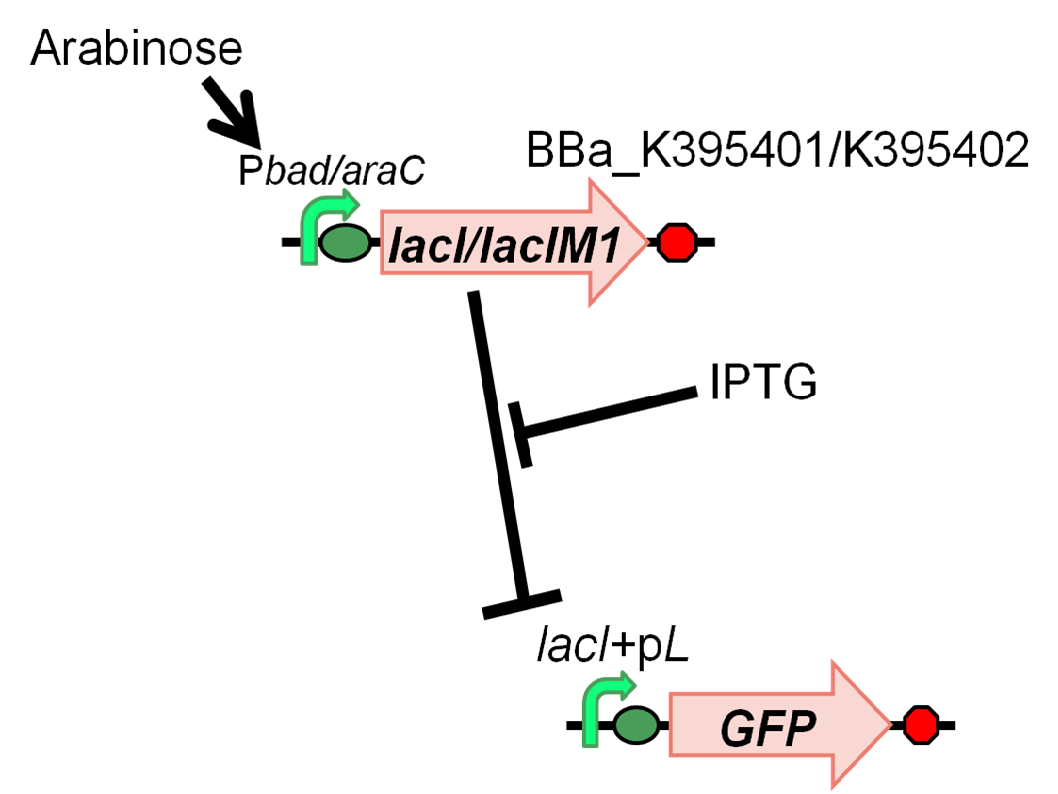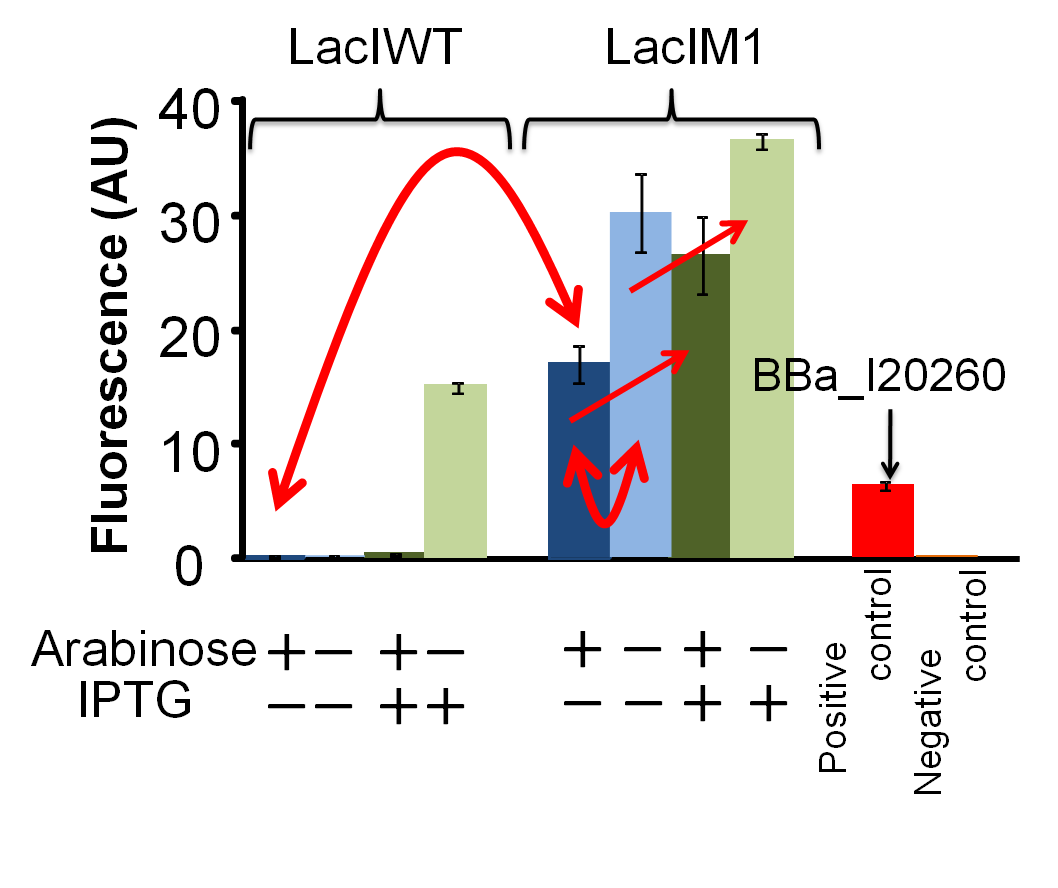Team:Tokyo Tech/Project/wolf coli/lacIM1
From 2010.igem.org
4-2 lacIM1 for band-detect network
Contents[hide] |
Abstract
We have characterized lacIM1 ([http://partsregistry.org/Part:BBa_K082026 BBa_K082026]) which is the key component in the band-detect network. (Fig. 3-2-1) [1]. Though this part was registered by USTC(2008) [2], its registered sequence is incorrect and it was not well characterized in their wiki. Therefore, we registered this part as BBa_K395400.
In order to measure the function of lacI proteins, we constructed following two plasmids, [http://partsregistry.org/Part:BBa_K395401 BBa_K395401] (LacIM1) and [http://partsregistry.org/Part:BBa_K395402 BBa_K395402] (LacIWT), which have an arabinose inducible promoter(Fig. 3-2-2). We measured GFP expression dependent on the input of arabinose and IPTG.
Introduction
What is LacIM1?
As I written before, LacIM1 LacIM1 shows weaker repression than LacIWT because it has a lower affinity to lac promoter [1].
Requirement for band-detect network
The band-detect network exhibits transient gene expression in response to concentration of chemical signals. In the band-detect network, LacIM1 is a key component because repression efficiency of LacIM1 can afford the network the desired non-monotonic response.
Results
(Figure3-2-1.
Repression efficiency of LacIM1 ([http://partsregistry.org/Part:BBa_K395401 BBa_K395401]) / LacIWT ([http://partsregistry.org/Part:BBa_K395402 BBa_K395402]) exposed to arabinose and IPTG.
Dark-blue bars, 0.2% arabinose and 0 mM IPTG;
blue bars, 0% arabinose and 0 mM IPTG;
dark-green bars, 0.2% arabinose and 1 mM IPTG;
green bars, 0% arabinose and 1 mM IPTG;
red bar, positive control
orange bar, negative control
GFP expression is dependent on the input of arabinose and IPTG. After 4 hours of arabinose and IPTG induction. Cultures were analysed by fluorometer (FLA5000、FUJI).
As positive control, we used BBa_I20260, which is measurement kit of the iGEM.)
After 4 hours of arabinose and IPTG induction. Cultures were analysed by fluorometer (FLA5000, FUJI).
This is the result of LacIM1.
In the absence of both arabinose and IPTG, GFP expression is about 1.8-folds stronger than that of the presence of arabinose and the absence of IPTG. We found that GFP expression is dependent on product of lacIM1 by arabinose induction. When there was LacIM1 by arabinose induction, GFP expression was repressed. That’s result shows that this repression is effect of LacIM1. This repression is dependent on product of lacIM1 by arabinose induction Therefore, This shows that this repression is the function of LacIM1. Increase of GFP production by addition of IPTG, with or without arabinose induction, shows the repressions are dependent on LacIM1. Without arabinose, increase of GFP production by addition of IPTG is leaky expression of LacIM1. This leaky expression could also explain the result of LacWT.
This is the result of LacIWT.
・In the presence of arabinose and the absence of IPTG, GFP expression did not occur.
This results show that LacI protein expressed by arabinose induction and fully repressed GFP expression.
・the absence of both arabinose and IPTG.
Normally without arabinose induction, the GFP expression is supposed to occur. However, GFP expression did not occur. This result shows that the product of leaky expressed lacI proteins sufficiently repressed GFP expression.
・the presence of both arabinose and IPTG.
Normally, although arabinose induction overproduces lacI protein and represses the GFP expression, lacI protein can be inhibited by IPTG. Therefore, we expected that the GFP expression occurred. However, there is no expression of GFP. This result shows that the amount of IPTG was not sufficient to inhibit the repression by overproduced LacI proteins.
・In the absence of arabinose and the presence of IPTG.
As I mentioned before, leaky expression of LacI proteins occurs in the absence of arabinose. In small amount of lacI proteins condition, addition of IPTG can fully inhibit the repression of LacI protein. Thus, GFP expression occurred.
Conclusion
We confirmed that lacIM1 shows weaker repression than LacIWT.
Materials&Methods
Bacterial strains and media
E. coli DH5α cells were grown in Luria-Bertani(LB) medium at 37°C for DNA manipulation and expression experiments. Cell growth was monitored as the optical density at a wavelength of 590 nm. Media were supplemented with ampicillin, kanamycin.
Report assay
Overnight cultures of reporter strains grown at 37 °C in LB Medium containing appropriated antibiotics were diluted at least 1:100 in the medium and were incubated at 37 °C as fresh cultures. After their OD590 reached 0.3, added appropriate inducers that 1mM IPTG, and/or 0.2% arabinose (final concentration). After 4 hours of induction, 150 l of each sample was applied to 96-well plate and its fluorescence intensity was measured with a fluorometer by BPB-sp filter, which emit LB. The fluorescence intensity was calculated by dividing the measured raw fluorescence intensity by the adjusted OD590.
Refference
[1]. Basu S, Gerchman Y, Collins CH, et al. A synthetic multicellular system for programmed pattern formation. NATURE 2005;434,1130-1134
[2]. USTC(2008)
 "
"

